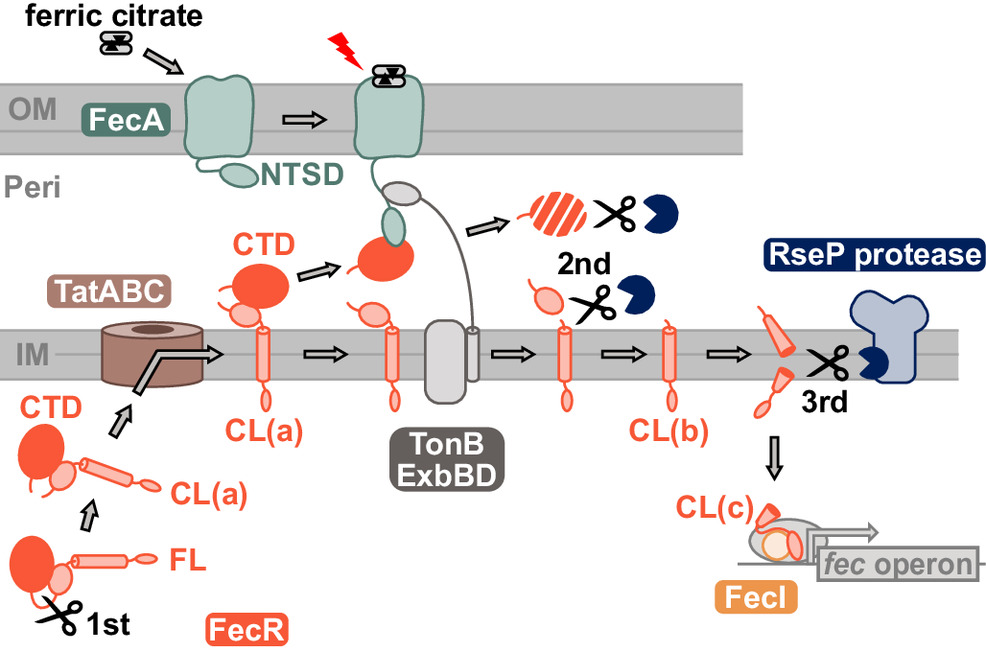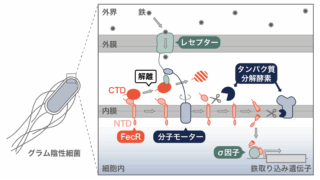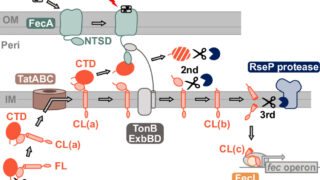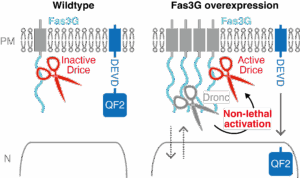Cleavage cascade of the sigma regulator FecR orchestrates TonB-dependent signal transduction

- グラム陰性細菌は環境中の鉄を効率的に取り込むために、外界の鉄を感知できることが知られています。本研究では、その分子メカニズムの一端を解明しました。
- グラム陰性細菌はTon motorと呼ばれる分子モーターが生み出す機械的な力を使って、鉄を細胞内に取り込みます。本研究ではこの力が、鉄の取り込みだけで無く、鉄の感知にも利用されていることを発見しました。
- Ton motorが生み出した機械的な力は、膜タンパク質FecRに伝えられ、それによってFecRタンパク質が連続した切断を受けることで、鉄が外界に存在するというシグナルが細胞内へと伝達されることを明らかにしました。
- 本成果は、タンパク質切断を介したシグナル伝達の新たなメカニズムを提示し、生体機能制御の基盤となる仕組みの一端を明らかにしたものです。
Significance: Scarcity of iron, an essential element for life, has driven bacteria to evolve intricate acquisition systems, yet the molecular basis of their signal transduction mechanisms remains elusive. Unlike conventional pathways, iron transport systems employ outer membrane receptors that mediate signal transduction across both the outer and cytoplasmic membranes, powered by TonB. Using the Escherichia coli Fec system, we uncovered the mechanism by which FecR’s cleavage cascade orchestrates ferric citrate signaling through TonB-mediated energy transfer. These findings shed light on similar mechanisms in gram-negative bacteria and have significant implications for understanding bacterial adaptation and pathogenesis.
Abstract: TonB-dependent signal transduction is a versatile mechanism observed in gram-negative bacteria that integrates energy-dependent substrate transport with signal relay. In Escherichia coli, the TonB–ExbBD motor complex energizes the TonB-dependent outer membrane transporter FecA, facilitating ferric citrate import. FecA also acts as a sensor, transmitting signals to the cytoplasmic membrane protein FecR, which eventually activates the cytoplasmic sigma factor FecI, driving transcription of the fec operon. Building on our previous finding that FecR undergoes functional maturation through a three-step cleavage process [T. Yokoyama et al., J. Biol. Chem. 296, 100673 (2021)], we here describe the complete mechanism of FecR-mediated ferric citrate signaling involving FecA and TonB. The cleavage cascade begins with FecR autoproteolysis prior to membrane integration. The soluble C-terminal domain (CTD) fragment of FecR is cotranslocated with the N-terminal domain (NTD) fragment through a twin-arginine translocation (Tat) system–mediated process. In the periplasm, the interaction between the CTD and NTD fragments prevents further cleavage. Binding of ferric citrate induces a conformational change in FecA, exposing its TonB box to the periplasmic space. This structural alteration is transmitted to the interacting FecR CTD via the motor function of TonB, resulting in the release of the CTD blockage from the NTD. Consequently, the successive cleavage of FecR’s NTD is initiated, culminating in the ferric citrate signal–induced activation of fec gene expression. Our findings reveal that the regulation of FecR cleavage, controlled by the TonB–FecA axis, plays a central role in the bacterial response to ferric citrate signals.
Authors: Tatsuhiko Yokoyama*, Ryoji Miyazaki, Takehiro Suzuki, Naoshi Dohmae, Hiroki Nagai, Tomoya Tsukazaki, Tomoko Kubori*, Yoshinori Akiyama* (*Corresponding authors)
Journal: Proc. Natl. Acad. Sci. U.S.A. (2025) 122 (16): e2500366122
Press release: 細菌が環境中の鉄の存在を「知る」しくみを解明(岐阜大学)
投稿者プロフィール
- 岐阜大学大学院医学系研究科 助教





